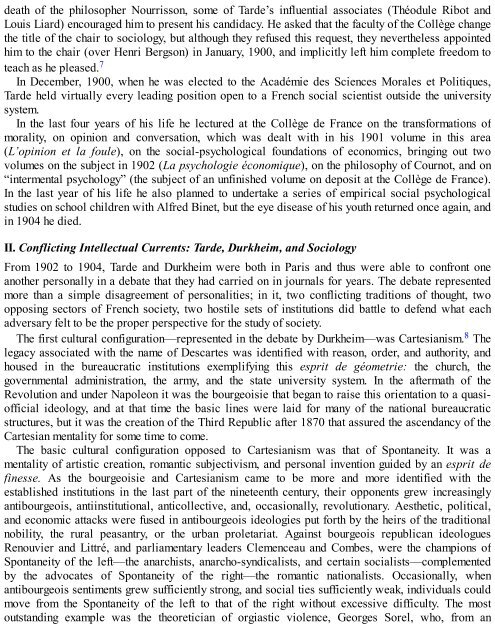3658925934
You also want an ePaper? Increase the reach of your titles
YUMPU automatically turns print PDFs into web optimized ePapers that Google loves.
death of the philosopher Nourrisson, some of Tarde’s influential associates (Théodule Ribot and<br />
Louis Liard) encouraged him to present his candidacy. He asked that the faculty of the Collège change<br />
the title of the chair to sociology, but although they refused this request, they nevertheless appointed<br />
him to the chair (over Henri Bergson) in January, 1900, and implicitly left him complete freedom to<br />
teach as he pleased. 7<br />
In December, 1900, when he was elected to the Académie des Sciences Morales et Politiques,<br />
Tarde held virtually every leading position open to a French social scientist outside the university<br />
system.<br />
In the last four years of his life he lectured at the Collège de France on the transformations of<br />
morality, on opinion and conversation, which was dealt with in his 1901 volume in this area<br />
(L’opinion et la foule), on the social-psychological foundations of economics, bringing out two<br />
volumes on the subject in 1902 (La psychologie économique), on the philosophy of Cournot, and on<br />
“intermental psychology” (the subject of an unfinished volume on deposit at the Collège de France).<br />
In the last year of his life he also planned to undertake a series of empirical social psychological<br />
studies on school children with Alfred Binet, but the eye disease of his youth returned once again, and<br />
in 1904 he died.<br />
II. Conflicting Intellectual Currents: Tarde, Durkheim, and Sociology<br />
From 1902 to 1904, Tarde and Durkheim were both in Paris and thus were able to confront one<br />
another personally in a debate that they had carried on in journals for years. The debate represented<br />
more than a simple disagreement of personalities; in it, two conflicting traditions of thought, two<br />
opposing sectors of French society, two hostile sets of institutions did battle to defend what each<br />
adversary felt to be the proper perspective for the study of society.<br />
The first cultural configuration—represented in the debate by Durkheim—was Cartesianism. 8 The<br />
legacy associated with the name of Descartes was identified with reason, order, and authority, and<br />
housed in the bureaucratic institutions exemplifying this esprit de géometrie: the church, the<br />
governmental administration, the army, and the state university system. In the aftermath of the<br />
Revolution and under Napoleon it was the bourgeoisie that began to raise this orientation to a quasiofficial<br />
ideology, and at that time the basic lines were laid for many of the national bureaucratic<br />
structures, but it was the creation of the Third Republic after 1870 that assured the ascendancy of the<br />
Cartesian mentality for some time to come.<br />
The basic cultural configuration opposed to Cartesianism was that of Spontaneity. It was a<br />
mentality of artistic creation, romantic subjectivism, and personal invention guided by an esprit de<br />
finesse. As the bourgeoisie and Cartesianism came to be more and more identified with the<br />
established institutions in the last part of the nineteenth century, their opponents grew increasingly<br />
antibourgeois, antiinstitutional, anticollective, and, occasionally, revolutionary. Aesthetic, political,<br />
and economic attacks were fused in antibourgeois ideologies put forth by the heirs of the traditional<br />
nobility, the rural peasantry, or the urban proletariat. Against bourgeois republican ideologues<br />
Renouvier and Littré, and parliamentary leaders Clemenceau and Combes, were the champions of<br />
Spontaneity of the left—the anarchists, anarcho-syndicalists, and certain socialists—complemented<br />
by the advocates of Spontaneity of the right—the romantic nationalists. Occasionally, when<br />
antibourgeois sentiments grew sufficiently strong, and social ties sufficiently weak, individuals could<br />
move from the Spontaneity of the left to that of the right without excessive difficulty. The most<br />
outstanding example was the theoretician of orgiastic violence, Georges Sorel, who, from an









![Genki - An Integrated Course in Elementary Japanese II [Second Edition] (2011), WITH PDF BOOKMARKS!](https://img.yumpu.com/58322134/1/180x260/genki-an-integrated-course-in-elementary-japanese-ii-second-edition-2011-with-pdf-bookmarks.jpg?quality=85)
![Genki - An Integrated Course in Elementary Japanese I [Second Edition] (2011), WITH PDF BOOKMARKS!](https://img.yumpu.com/58322120/1/182x260/genki-an-integrated-course-in-elementary-japanese-i-second-edition-2011-with-pdf-bookmarks.jpg?quality=85)





